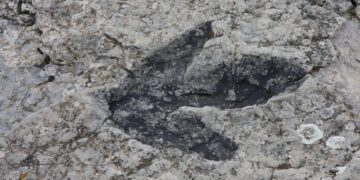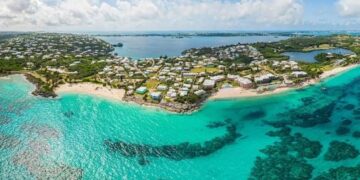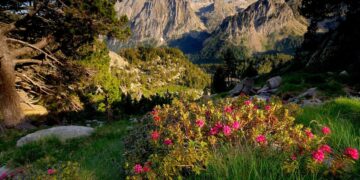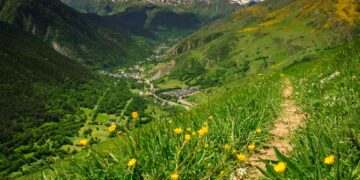Less than an hour from Lisbon, this little-known region is home to some of Portugal’s best beaches. Arrábida Natural Park, located around 45 minutes’ drive south of Lisbon in Sesimbra, is a protected coastal region that offers stunning landscapes and crystal clear waters. The park stretches to the coastal city of Setúbal and is characterized by white limestone cliffs, dense Mediterranean vegetation, and turquoise waters.
Sesimbra, a charming fishing village at one end of the natural park, is where writer Lucy Bryson has made her home since 2015. The village is surrounded by rugged mountains that slope down towards beautiful white sand beaches, making it a hidden gem for beach lovers. The region is also known for its cold but crystal clear waters, perfect for activities like cold water swimming and kayaking, as well as enjoying local wines, cheeses, and barbecue sessions.
In recent years, interest in Arrábida has been quietly building, leading to changes in the area. The former four-star Sesimbra Hotel & Spa has been renovated and rebranded as the five-star Sesimbra Oceanfront, attracting more upscale travelers. However, the local charm of Sesimbra remains, with locals enjoying strong espressos and fresh-from-the-ocean fish grilled on rustic charcoal grills set out on the cobbled streets.
Nearby beaches like Ribeiro do Cavalo, accessible only by steep trails or water, are often compared to beaches in Thailand and have become popular with Lisbon locals. Improved bus links to the city have made these once-hidden gems more accessible, attracting more visitors to the region. The beaches along the Arrábida coast are frequently named among the most beautiful in Portugal, with picturesque spots like Portinho da Arrábida offering simple fish restaurants overlooking the water.
Overall, Arrábida Natural Park and its surrounding beaches offer a perfect escape from the bustling city life of Lisbon, providing a tranquil and scenic setting for visitors to enjoy the natural beauty of Portugal’s coastline. Whether you’re looking for a relaxing beach getaway or an active outdoor adventure, this little-known region has something for everyone to enjoy. Op minder dan een uur van Lissabon verwijderd, ligt deze relatief onbekende regio die enkele van de beste stranden van Portugal herbergt. Vanaf hier strekt de kust zich uit naar Setúbal en is bezaaid met bossen omzoomde stranden, elk schijnbaar nog mooier dan de vorige.
Deze paradijselijke stranden kunnen in het hoogseizoen (juni-september) lastig te bereiken zijn zonder enige planning. Vanwege het delicate ecosysteem hebben de autoriteiten de toegang voor privéauto’s beperkt (Ubers en Bolts zijn toegestaan en worden veel gebruikt) tot de meest populaire stranden tijdens de piekmaanden van de zomer en blokkeren politiecontroles hoopvolle bestuurders bij controlepunten langs de kustwegen. De alternatieven zijn pendelbussen van Setúbal naar plekken zoals Portinho da Arrábida en Figueirinha, wandelen over de kustpaden of kajakken langs de kust. Het is een noodzakelijke maatregel voor dit beschermde landschap, waar ongerepte stranden beperkt blijven tot een handvol strandrestaurants en waar het niet ongebruikelijk is om wilde zwijnen te zien rondsnuffelen naar restjes.
In het voor- en naseizoen bieden lente- en herfstmaanden aangename stranddagen zonder de kustverwarring en met gemakkelijker toegang tot afgelegen plekken. De kustlijn, met zijn verborgen baaien – waaronder één met een steile afdaling naar een kleine kapel verstopt binnenin – kan worden verkend per boot of coasteering expeditie met avontuurlijke exploitanten zoals het in Sesimbra gevestigde Vertente Natural. Voor degenen die de voorkeur geven aan het verkennen te voet, biedt het park uitstekende trailrunning- en wandelroutes die ik in de loop der jaren goed heb leren kennen.
Verdere schatten liggen landinwaarts. Arrábida ligt binnen de wijnstreek van het schiereiland Setúbal en is bezaaid met wijngaarden, van gevierde landgoederen zoals het historische José Maria da Fonseca – dat enkele van de oudste tafelwijnen van Portugal maakt vanuit het prachtige hoofdkwartier in het schilderachtige wijndorp Azeitão – tot kleinschalige producenten zoals Quinta de Alcube. Deze off-the-beaten-track-wijngaard, omgeven door wijngaarden en door de zon gebakken heuvels, is waar de lokale bevolking lange, luie middagen doorbrengt in de schaduw van kurkeiken, aan tafels beladen met lokale kazen, olijven en charcuterie. Wees niet bang om brood in de olijfolie en de boterachtige schapenmelkkaas, queijo de azeitão, te dippen.
Als je niet kunt kiezen tussen natuur en gemakkelijke toegang tot stranden, restaurants en uitstekende wijn, dan slaat Casa Palmela de gulden middenweg in stijl. Deze verfijnde maar huiselijke pousada biedt een prachtig restaurant ter plaatse en hectares kronkelende paden die geschikt zijn voor paardrijden of wandelen, en is binnen handbereik van nabijgelegen stranden en wijngaarden. Zelfs in het hoogseizoen worden dagen en nachten hier onderbroken door vogelgezang en roepende uilen in plaats van drukte of verkeer.
Voor wilde golven, gemakkelijke toegang tot het strand en een enorm stuk zand is de strandwijk Meco een populaire keuze, met bars die in de zomer bruisen en herenhuizen die discrete boetiekhotels huisvesten zoals Quinta do Miguel.
Zelfs nu het woord zich verspreidt, voelt de regio nog steeds als een goed bewaard geheim. Toen ik in 2015 aankwam, kende ik heel weinig andere buitenlanders in Sesimbra, en het culinaire aanbod weerspiegelde het dorpsmotto: ‘Sesimbra is vis.’ Dit is inderdaad een op vis gericht stadje, met de lokale bevolking bekend als ‘peixitos’ of kleine visjes. Vandaag de dag betekent de groeiende internationale gemeenschap dat de lokale bevolking net zo waarschijnlijk een pittige margarita drinkt als de traditionele o pescador (visser) likeur van de stad.
Terwijl er een toenemend aantal internationale eetgelegenheden en veganistische cafés zijn, blijft de vis hier een groot deel van de aantrekkingskracht voor fijnproevers. Als Setúbal terecht trots is op zijn choco frito (gefrituurde, gepaneerde pijlinktvissen geserveerd met friet – de lokale versie van fish and chips), houdt Sesimbra de kroon voor verse vis. Lokalen staan in de rij bij de alleen contant, zonder reserveringen Tasca do Isaías, waar de vangst van de dag elke ochtend bij de ingang wordt opgeschreven, en tafels en stoelen staan op schuine hoeken op de vlagstenen buiten. Mis espadarte (zwaardvis) niet als het op het menu staat.
De geplaveide achterstraten blijven gevuld met traditionele marisqueiras die schotels schaal- en schelpdieren en kreeftachtigen verkopen, maar er is zichtbare modernisering langs de waterkant: de helft van de lang bestaande lokale visplek Ribamar is nu Ribabar – een rustgevende, smaakvol verlichte ruimte die kunstzinnig opgemaakte sashimi en pan-Aziatische visgerechten serveert.
De transportverbindingen zijn drastisch verbeterd sinds ik hierheen verhuisde. Hetzelfde bedrijf dat de bussen van Lissabon exploiteert, verzorgt nu diensten naar Sesimbra, en een maandelijks pass van €40 dekt beide, waardoor het dorp een populaire bestemming is voor dagtochten voor Lisboetas.
De beschermde status betekent dat nu Arrábida verdiende internationale aandacht krijgt, er weinig gevaar is dat hoogbouw zal opduiken tussen de wilde bloemen die van kleur veranderen met de seizoenen. Less than an hour from Lisbon, this little-known region is home to some of Portugal’s best beaches. At the height of summer, visitors can still find splendid isolation on morning trail runs and cold water swims. Even without the dolphins, swimming across the bay as the sun rises over the forested hills always feels magical.
To get to this hidden gem, travelers can fly direct from London Heathrow to Lisbon with TAP Air Portugal or Ryanair, with return flights starting from £89. From Lisbon, they can take a bus from Sete Rios to Sesimbra, which is only a 45-minute journey outside of rush hour. Alternatively, renting a car provides greater flexibility in exploring the wider region.
For accommodation, Casa Palmela outside of Setúbal is a great option. This charming hotel is within easy reach of nearby beaches and wineries, offering a peaceful retreat for visitors looking to relax and unwind. The hotel provides a comfortable and welcoming atmosphere, making it the perfect base for exploring the surrounding area.
With its stunning beaches, picturesque landscapes, and peaceful atmosphere, this little-known region near Lisbon is a hidden paradise waiting to be discovered. Whether you’re looking for relaxation or adventure, this area has something for everyone. Plan your trip now and experience the magic of Portugal’s best beaches just a short distance from the bustling city of Lisbon. Less than an hour from Lisbon, the capital of Portugal, lies a little-known region that is home to some of the country’s best beaches. This region, known as the Costa da Caparica, is a hidden gem that is waiting to be explored by beach lovers and sun seekers alike.
The Costa da Caparica is located on the southern bank of the Tagus River, just a short ferry ride or drive away from Lisbon. Despite its close proximity to the bustling city, this region remains relatively undiscovered by tourists, making it the perfect destination for those looking to escape the crowds and enjoy a more laid-back beach experience.
One of the main attractions of the Costa da Caparica is its stunning coastline, which stretches for over 30 kilometers and is dotted with beautiful sandy beaches. Whether you’re looking for a peaceful spot to relax and soak up the sun or a more lively beach with plenty of water sports and activities, you’re sure to find the perfect beach for you in this region.
In addition to its pristine beaches, the Costa da Caparica also boasts a charming beach town that is worth exploring. Here, you’ll find colorful fishing boats bobbing in the harbor, quaint cafes serving up fresh seafood, and traditional Portuguese restaurants where you can sample the local cuisine.
For those looking to explore beyond the beaches, the Costa da Caparica has plenty to offer. Outdoor enthusiasts can enjoy hiking and biking trails that wind through the region’s lush forests and sand dunes, while history buffs can visit ancient castles and fortresses that date back to the 16th century.
Overall, the Costa da Caparica is a hidden paradise that offers the perfect combination of natural beauty, cultural charm, and outdoor adventure. Whether you’re looking for a relaxing beach getaway or an active holiday exploring the great outdoors, this little-known region has something for everyone. So why not escape the crowds and discover the hidden treasures of the Costa da Caparica on your next trip to Portugal?






























































